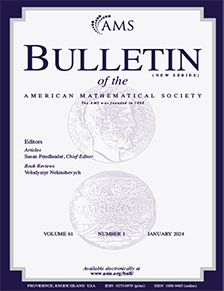Book Review
The AMS does not provide abstracts of book reviews.
You may download the entire review from the links below.
MathSciNet review:
1567802
Full text of review:
PDF
This review is available free of charge.
Book Information:
Author:
Michael Sharpe
Title:
General theory of Markov processes
Additional book information:
Academic Press, San Diego, 1988, xi + 419 pp., $49.50. ISBN 0-12-639060-6.
Jacques Azéma, Théorie générale des processus et retournement du temps, Ann. Sci. École Norm. Sup. (4) 6 (1973), 459–519 (1974) (French). MR 365725
Jacques Azéma, Quelques applications de la théorie générale des processus. I, Invent. Math. 18 (1972), 293–336 (French). MR 326848, DOI 10.1007/BF01389817
R. M. Blumenthal, An extended Markov property, Trans. Amer. Math. Soc. 85 (1957), 52–72. MR 88102, DOI 10.1090/S0002-9947-1957-0088102-2
Kai Lai Chung, Lectures on boundary theory for Markov chains, Annals of Mathematics Studies, No. 65, Princeton University Press, Princeton, N.J.; University of Tokyo Press, Tokyo, 1970. With the cooperation of Paul-André Meyer. MR 0267644
J. L. Doob, Conditional Brownian motion and the boundary limits of harmonic functions, Bull. Soc. Math. France 85 (1957), 431–458. MR 109961
J. L. Doob, Semimartingales and subharmonic functions, Trans. Amer. Math. Soc. 77 (1954), 86–121. MR 64347, DOI 10.1090/S0002-9947-1954-0064347-X
E. B. Dynkin, Markov processes and related problems of analysis, London Mathematical Society Lecture Note Series, vol. 54, Cambridge University Press, Cambridge-New York, 1982. MR 678918
E. B. Dynkin, Wanderings of a Markov process, Teor. Verojatnost. i Primenen. 16 (1971), 409–436 (Russian, with English summary). MR 0293721
Ronald K. Getoor, Markov processes: Ray processes and right processes, Lecture Notes in Mathematics, Vol. 440, Springer-Verlag, Berlin-New York, 1975. MR 0405598
Hunt (G. A. ) [1], Markov processes and potentials. I, II, III, Illinois J. Math. 1 (1957), 44-93; 1 (1957), 313-369; 2 (1958), 151-213.
Frank Knight, Note on regularization of Markov processes, Illinois J. Math. 9 (1965), 548–552. MR 177450
Kuznetsov (S. E. ) [1], Construction of Markov processes with random times of birth and death, Theory Probab. Appl. 18 (1974), 571-574.
Bernard Maisonneuve, Exit systems, Ann. Probability 3 (1975), no. 3, 399–411. MR 400417, DOI 10.1214/aop/1176996348
J. B. Walsh and P. A. Meyer, Quelques applications des résolvantes de Ray, Invent. Math. 14 (1971), 143–166 (French). MR 295436, DOI 10.1007/BF01405361
Joanna B. Mitro, Dual Markov processes: construction of a useful auxiliary process, Z. Wahrsch. Verw. Gebiete 47 (1979), no. 2, 139–156. MR 523166, DOI 10.1007/BF00535279
Daniel Ray, Resolvents, transition functions, and strongly Markovian processes, Ann. of Math. (2) 70 (1959), 43–72. MR 107302, DOI 10.2307/1969891
D. Revuz, Mesures associées aux fonctionnelles additives de Markov. I, Trans. Amer. Math. Soc. 148 (1970), 501–531 (French). MR 279890, DOI 10.1090/S0002-9947-1970-0279890-7
C. T. Shih, On extending potential theory to all strong Markov processes, Ann. Inst. Fourier (Grenoble) 20 (1970), no. fasc. 1, 303–315 (English, with French summary). MR 288845
- Azéma (J. ) [1], Théorie générale des processus et retournement du temps, Ann. Sci. École. Norm. Sup. 6 (1973), 35-50. MR 0365725
- Azéma (J. ) [2], Quelques applications de la théorie générale des processus, Invent. Math. 18 (1972), 293-336. MR 326848
- Blumenthal (R. M. ) [1], An extended Markov property, Trans. Amer. Math. Soc. 85 (1957), 52-72. MR 88102
- Chung (K. L. ) [1], Lectures on boundary theory for Markov chains, Ann. of Math. Studies, Princeton Univ. Press, Princeton, N. J., 1970. MR 267644
- Doob (J. L. ) [1], Conditional Brownian motion and the boundary limits of harmonic functions, Bull. Soc. Math. France 85 (1957), 431-458. MR 109961
- Doob (J. L. ) [2], Semimartingales and subharmonic functions, Trans. Amer. Math. Soc. 77 (1954), 86-121. MR 64347
- Dynkin (E. B. ) [1], Markov processes and related problems of analysis, London Math. Society Lecture Notes no. 54, 1982. MR 678918
- Dynkin (E. B. ) [2], Wanderings of a Markov process, Theory Probab. Appl. 16 (1971), 401-408. MR 293721
- Getoor (R. K. ) [1], Markov processes: Ray processes and right processes, Lecture Notes in Math., vol. 440, Springer-Verlag, Berlin and New York, 1975. MR 405598
- Hunt (G. A. ) [1], Markov processes and potentials. I, II, III, Illinois J. Math. 1 (1957), 44-93; 1 (1957), 313-369; 2 (1958), 151-213.
- Knight (F. B. ) [1], Note on regularization of Markov processes, Illinois J. Math. 9 (1965), 548-552. MR 177450
- Kuznetsov (S. E. ) [1], Construction of Markov processes with random times of birth and death, Theory Probab. Appl. 18 (1974), 571-574.
- Maisonneuve (B. ) [1], Exit systems, Ann. Probab. 3 (1978), 399-411. MR 400417
- Meyer (P. A. ) and Walsh (J. B. ) [1], Quelques applications des résolvantes de Ray, Invent. Math. 14 (1971), 143-166. MR 295436
- Mitro (J. ) [1], Dual Markov processes: construction of a useful auxiliary process, Z. Wahrsch. Verw. Gebiete 47 (1979), 139-156. MR 523166
- Ray (D. B. ) [1], Resolvents, transition functions and strongly Markovian processes, Ann. of Math. (2) 70 (1959), 43-72. MR 107302
- Revuz (D. ) [1], Mesures associées aux fonctionnelles additives de Markov. I, Trans. Amer. Math. Soc. 148 (1970), 501-531; II, Z. Wahrsch. Verw. Gebiete 16 (1970), 336-344. MR 279890
- Shih (C. T. ) [1], On extending potential theory to all strong Markov processes, Ann. Inst. Fourier (Grenoble) 20-1 (1970), 303-415. MR 288845
Review Information:
Reviewer:
Paul André Meyer
Journal:
Bull. Amer. Math. Soc.
21 (1989), 292-296
DOI:
https://doi.org/10.1090/S0273-0979-1989-15833-3


